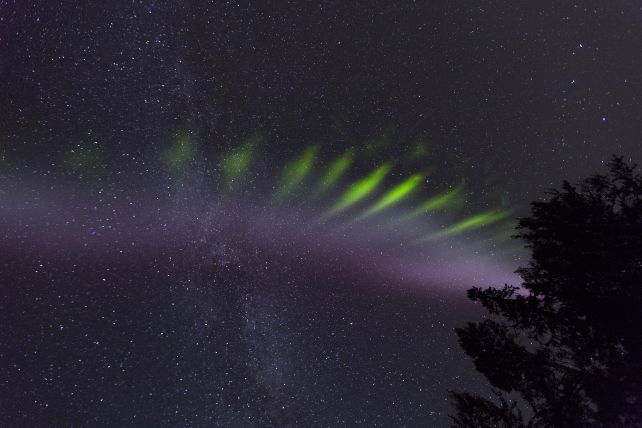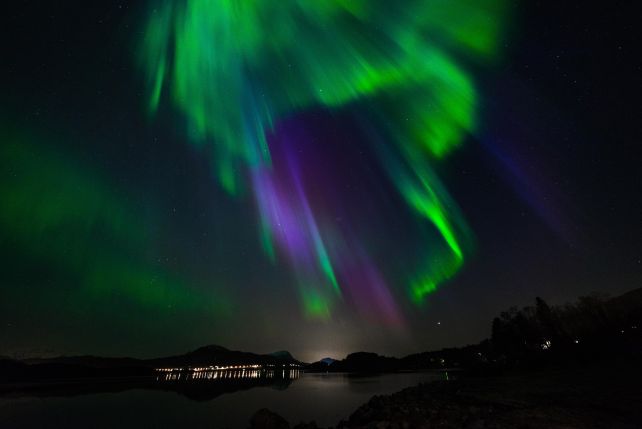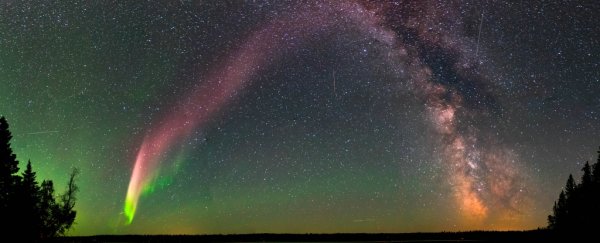When the Sun gets rowdy, Earth's sky lights up with beautiful dancing lights.
Around the poles, colorful auroral streams dance and flicker across the sky. Closer to the equator, though, a different empyrean glow appears: the blushing, mauve-pink STEVE, and its attendant green-striped picket fence.
What these lights are, and why they appear in our sky, is something of a mystery. Scientists have previously thought that, because they look similar to auroras, they might be related, but the mechanisms behind the phenomenon have remained elusive.
Now, a new paper proposes a radical idea: that STEVE and the picket fence are distinctly not auroras, but something else.
Rather than being produced by magnetic fields like the auroras, says a team led by physicist Claire Gasque of the University of California Berkeley, STEVE and the picket fence are produced by electric fields parallel to the magnetic field lines, at lower latitudes than the aurora.
If this is the case, it has profound implications for our understanding of Earth's atmosphere, magnetosphere, their interplay, and the physics thereof.
"We've known for a couple of years now that the STEVE spectrum is telling us there's some very exotic physics going on. We just didn't know what it was," says physicist Brian Harding of UC Berkeley. "Claire's paper showed that parallel electric fields are capable of explaining this exotic spectrum."

Auroras are, truly, one of the most beautiful sights Earth has to offer. They also have a really interesting physical explanation. They occur when particles from the Sun, such as those gusted out in a powerful solar wind, or spewed out in a giant eruption such as a flare, are flung out into space in Earth's direction.
When they hit Earth's protective magnetosphere, most of them just bounce off again, but some are captured, accelerating along magnetic field lines to higher latitudes, where they are pelted down into the upper atmosphere. There, they collide with atmospheric atoms and molecules, briefly exciting them and causing them to glow.
This is the aurora, and its colors range from green to yellow to pink to red to purple, based on which atoms are being ionized. Green is oxygen. Purple or blue is nitrogen. Blood red, which is one of the rarer manifestations, is oxygen, but it's really high up in the atmosphere and only occurs during the most energetic solar events.
And then there's STEVE, in strange mauve-and-white, sometimes accompanied by a striped green feature known as a picket fence. STEVE – Strong Thermal Emission Velocity Enhancement – was formally identified as a separate phenomenon in 2018, and scientists have been trying to figure it out for years.
"It's really cool," Gasque says. "It's one of the biggest mysteries in space physics right now."
Scientists thought that STEVE may have been created by a stream of ionized atoms in the upper atmosphere that don't rain down like auroral particles do, known as a subauroral ion drift or SAID. The picket fence was thought to be the result of particles falling out of a STEVE.
But scientists aren't sure how a SAID – which is usually not associated with a STEVE – could produce the STEVE-y glow. And Gasque and her team thought there may be another explanation for the picket fence.
"If you look at the spectrum of the picket fence, it's much more green than you would expect. And there's none of the blue that's coming from the ionization of nitrogen," she explains.
"What that's telling us is that there's only a specific energy range of electrons that can create those colors, and they can't be coming from way out in space down into the atmosphere, because those particles have too much energy."

Instead, Gasque and her team have now shown that the particles in the picket fence are being excited locally by an electric field, rather than falling from a higher altitude to a lower one – which is an entirely different mechanism than the one behind aurora.
And STEVE, their paper suggests, could be produced by a similar process.
There's a good way to find out. The researchers reckon we need to blast a rocket into STEVE or the picket fence to test it directly. That could be tricky, since the phenomena are relatively rare, but the first target could be an enhanced aurora – regions of more intense light that sometimes appear embedded in an aurora. Their colors are very similar to the colors of the picket fence.
These features are also thought to be produced by electric fields. And, since enhanced aurora are more common than STEVE, they offer a more accessible opportunity.
"It's fair to say that there's going to be a lot of study in the future about how those electric fields got there, what waves they are or aren't associated with, and what that means for the larger energy transfer between Earth's atmosphere and space," Harding says. "We really don't know. Claire's paper is the first step in the chain of that understanding."
The research has been published in Geophysical Research Letters.
